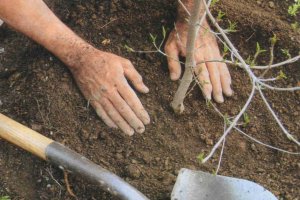 Cherry in a fruit farm is one of the most attractive trees. In addition to her beauty, she brings a good harvest, but the most appropriate care is required. Equally important is time and landing technology. You should know what time and place is more suitable for transplanting cherries in the fall to a new place.
Cherry in a fruit farm is one of the most attractive trees. In addition to her beauty, she brings a good harvest, but the most appropriate care is required. Equally important is time and landing technology. You should know what time and place is more suitable for transplanting cherries in the fall to a new place.
Content
Transplant suitable period
The adaptation of the tree in the soil is much faster if you carefully follow the correctly selected growing conditions. There are certain rules recommended by professional gardeners. The best time to start transplanting shrubs, seedlings and perennials is autumn.
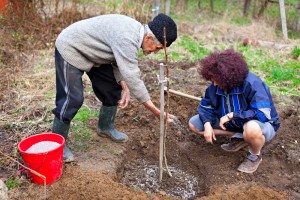 You can not only eat fresh cherries, but also make tasty jam or jelly for the winter, cook compotes, add them to cakes and pies. And dumplings with this berry become the main dish of many housewives in the country. Growing it on your own plot is quite simple. But sometimes there is a need to transplant a bush. What to do in this case? What should be done to save the tree and in the future it will bear fruit? The following recommendations will help to transplant cherries correctly, without the risk of losing the plant.
You can not only eat fresh cherries, but also make tasty jam or jelly for the winter, cook compotes, add them to cakes and pies. And dumplings with this berry become the main dish of many housewives in the country. Growing it on your own plot is quite simple. But sometimes there is a need to transplant a bush. What to do in this case? What should be done to save the tree and in the future it will bear fruit? The following recommendations will help to transplant cherries correctly, without the risk of losing the plant.
Watering, fertilizing, pruning, grooming and other important procedures must be carried out on time and without delay. Otherwise, negative consequences cannot be avoided.
Video:
How to choose a new place?
If a cherry transplant is planned for the fall, you should make sure that it is appropriate. It often happens that in a new place a tree, especially if it is more than 5 years old, no longer bears fruit.
But there are situations in which it is necessary to transplant a tree. This usually happens because the primary location is not suitable for it:
- next to the wall of the house;
- there are too many other trees or bushes in the neighborhood;
- it is required to free a site.
[sc name = "info-dashed" text = "When transplanting, it is important to follow all the rules. The best time for this is early spring or fall. Once again, it should be repeated that transplanting cherries should be done only if absolutely necessary. Professional gardeners do not recommend disturbing the root system of an adult plant unnecessarily. ”]
Another important nuance is the age of the tree. The younger the cherry, the easier the adaptation. For transplanting bushes in the early stages, all long branches should be cut. Thus, the root system will not spend a large amount of nutrients on their nutrition, and will begin to develop itself.
The only type of cherry that you should definitely transplant is a overgrown tree. Most often, such bushes interfere with the fruiting of the main plant, taking away all the minerals from its roots. The overgrown cherry does not have its root, so digging it up will not be difficult. This approach will save the adult bush and grow a new fruiting tree.
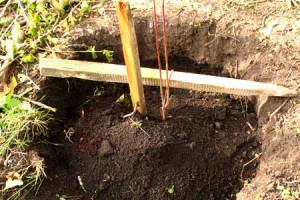 When choosing a new place for cherries, several rules should be observed:
When choosing a new place for cherries, several rules should be observed:
- The area should be adequately lit, as this species loves the sun's rays.
- It is best to choose a place on a hill with fertile soil with neutral acidity Ph.
- It is not recommended to transplant into the ground with marshy soil, this can develop rotting of the root system and the plant will die.
- The recommended transplant of cherries in the fall to a new place is carried out only at pre-agreed dates.
- The best time for transplantation, especially of coppice cherries, is September-early October. By this moment, most of the leaves have already fallen, but the air temperature is optimal for the necessary adaptation of the bushes.
The results show that autumn transplants are much more effective than spring ones. The plant begins to bear fruit much earlier and more.
How to transplant?
Each type of work on the site has its own instructions and rules. It is especially important to get acquainted with them if such an operation as a cherry transplant is carried out for the first time. Without following the rules, you can harm the plant and not achieve the desired result. In order for a new tree to take root, it is important to observe the following rules:
- The depth, as well as the diameter of the pit for planting, is taken into account from the size of the root system of the selected plant.
- The selected place should be well fertilized with wood ash, compost, phosphorus and potassium substances.
- In a cherry bush, the root system has almost the same diameter as the crown. This feature should be noted when digging a tree.
- The root system of the bush should be protected with a rag or cellophane to avoid damage.
- If there are dry roots on the seedlings, then they must be lowered into the water for several hours before planting the tree in a new place.
- Cherry is placed in the center of the landing pit, after which the root begins to fall asleep. Each new layer should be well compacted. It is important to fill the hole only with fertile soil.
- A tree planted in a new place can be protected from obstruction. To do this, a peg is driven in next to which the plant is tied.
- After transplanting, cherries require abundant watering.
- Mulching with the help of fallen leaves will help protect the soil from drying out. Thus, not only moisture is preserved, but also the root system is protected from the coming winter frosts.
[sc name = "info-attention" text = "For a rich and high-quality harvest, it is recommended to plant 4-5 trees on one site at a distance of 2.5 meters from each other. At this distance, the root system of each plant will receive enough water and fertilizer. Such planting will affect not only the taste and size of berries, but also pollination. ”]
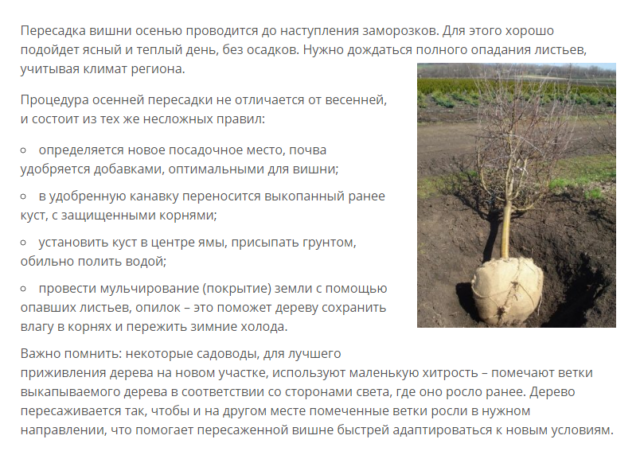
Important Features
 For gardeners and gardeners, amateurs should remember that the most effective is the transplantation of overgrown cherries or very young bushes, up to 3-5 years. Their adaptation is much faster than that of an adult plant, so you can expect fruiting earlier.
For gardeners and gardeners, amateurs should remember that the most effective is the transplantation of overgrown cherries or very young bushes, up to 3-5 years. Their adaptation is much faster than that of an adult plant, so you can expect fruiting earlier.
It is absolutely impossible to carry out a transplant in the summer and winter. Also, do not disturb the plant during flowering. In the hot season, the root system of the cherry is likely to dry during transplantation, and in the winter, the tree will simply freeze.
The only kind of cherry that should not be transplanted is felt. This feature of this type of plant, which has the shortest period of fruitfulness. Felt cherry will not have time to settle down to a new place, adapt on it and give a new crop. Thus, transplanting this variety is not practical at all. Correct transplantation of cherries in the fall to a new place should be carried out in strict accordance with the recommendations.
As you can see, in order to transplant the cherry bush to a new place, it does not take a lot of time and effort, therefore this operation occurs quickly and without special expenses. But even such work should be treated with great responsibility. It is important to follow only the recommendations listed. The decisive factor in this type of work will be the choice of a suitable place, soil quality, plant age and transplant time. It is also worth monitoring the safety of the root system when an adult tree is transplanted. Given all these factors, the new plant will take root quickly and will continue to bear fruit.
Gardener tips
With the correct transplant of cherries in the fall to a new place, you can guarantee high yields. This is a very important factor that many experts pursue. But how to achieve a good result?
- First of all, it is top dressing. Any plant needs appropriate care, mineral fertilizers. Of course, digging and adding humus will be enough, but you can use ready-made complexes.
- Do not forget about the mulch. This aspect is often overlooked by amateur gardeners, since they believe that there is no need for this. Mulch protects the soil not only from freezing, but also creates good fertilizer during the life of microorganisms. Do not neglect this advice.
- Watering before wintering should be plentiful. You need to spend about 50-70 liters of water per tree. It is very important to create an area where the cherry will feed.

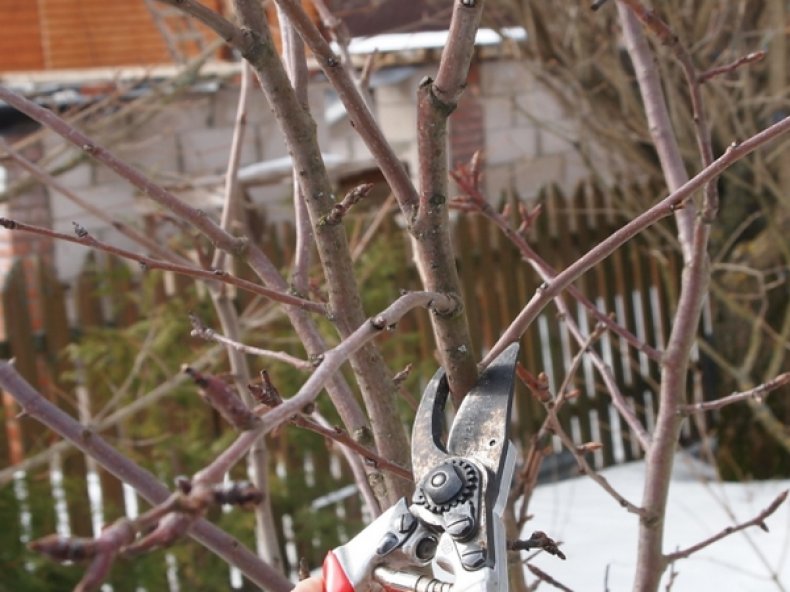
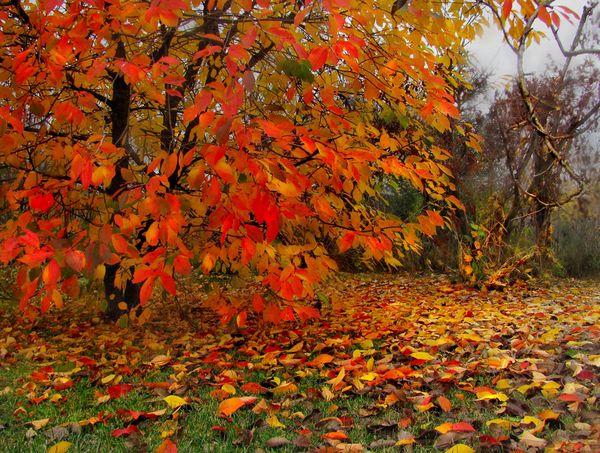
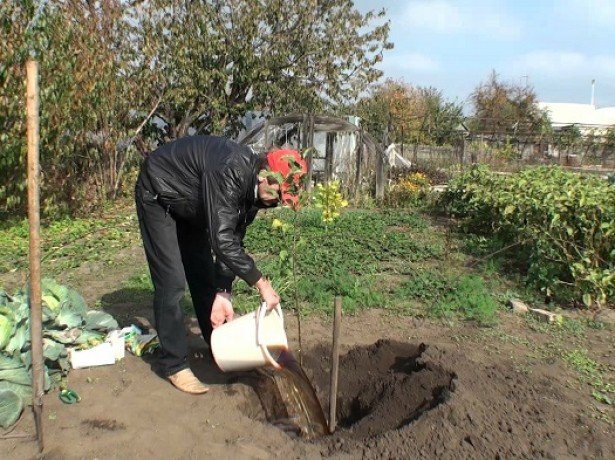
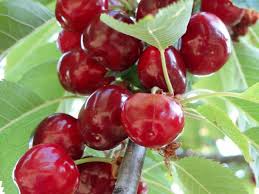 All about the Turgenevskaya cherry variety
All about the Turgenevskaya cherry variety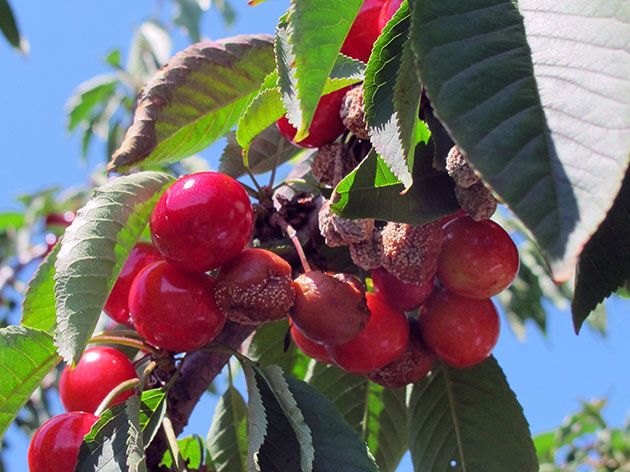 Cherry Disease: Description with Photos
Cherry Disease: Description with Photos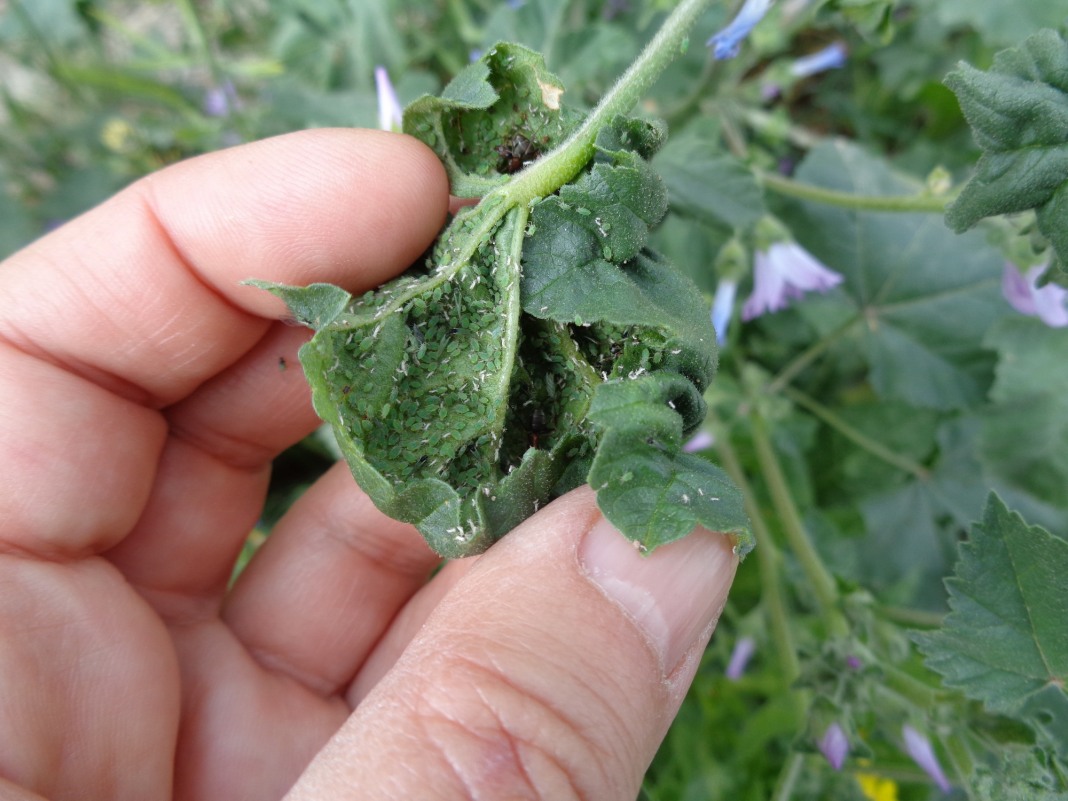 Ways to get rid of aphids on cherries
Ways to get rid of aphids on cherries